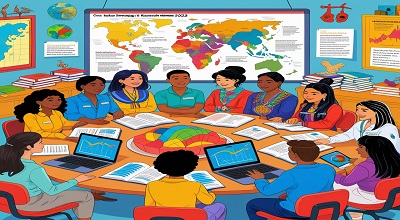Cross-Cultural Teaching Strategies
In 2025, the landscape of education has evolved to prioritize cross-cultural competencies, reflecting the increasing diversity and interconnectedness of our global society. Educators are now more than ever required to implement teaching strategies and research methods that acknowledge and celebrate cultural differences, fostering inclusive and effective learning environments. This comprehensive guide explores the key features of cross-cultural teaching strategies and research methods pertinent to 2025.
Key Features
1. Culturally Responsive Pedagogy:
Culturally responsive pedagogy involves recognizing the cultural backgrounds of students and integrating this awareness into teaching practices. Educators adapt their instructional methods to connect with students’ cultural contexts, thereby enhancing engagement and comprehension. This approach includes using culturally relevant examples, materials, and references that resonate with the diverse student body. By doing so, teachers validate students’ cultural identities and promote a more inclusive classroom environment.
2. Differentiated Instruction:
Differentiated instruction is a strategy where teachers proactively modify curricula, teaching methods, and resources to address the diverse needs of students. This approach ensures that all learners, regardless of their cultural or linguistic backgrounds, have equitable access to education. Techniques include offering varied learning materials, employing multiple forms of assessment, and providing choices in learning activities. By tailoring instruction to individual learning styles and cultural contexts, educators can enhance student achievement and motivation.
3. Collaborative Learning:
Collaborative learning emphasizes student interaction and cooperation in the learning process. By engaging in group work, discussions, and projects, students from diverse backgrounds share perspectives and develop critical thinking skills. This method not only fosters a sense of community but also prepares students to work effectively in multicultural settings. Educators facilitate this by creating diverse groups and promoting respectful dialogue, ensuring that all voices are heard and valued.
4. Inclusive Curriculum Design:
An inclusive curriculum reflects the diverse histories, cultures, and contributions of various groups. In 2025, educators are tasked with designing curricula that go beyond the traditional Eurocentric narratives, incorporating multicultural perspectives across subjects. This includes selecting texts, examples, and case studies that represent a wide range of cultures and experiences, thereby providing students with a more comprehensive understanding of the world.
5. Technology Integration:
The integration of technology in education has opened avenues for cross-cultural exchanges and learning opportunities. Virtual classrooms, online collaborative platforms, and digital resources allow students and educators to connect globally, sharing diverse cultural insights. Technology also supports differentiated instruction by providing various tools and resources that cater to different learning styles and needs. Educators are encouraged to leverage technology to create interactive and culturally rich learning experiences.
6. Professional Development in Cultural Competence:
Ongoing professional development is crucial for educators to effectively implement cross-cultural teaching strategies. Training programs focused on cultural competence equip teachers with the knowledge and skills to understand and address the cultural dynamics in their classrooms. This includes learning about cultural communication styles, values, and educational expectations, enabling educators to create more responsive and supportive learning environments.
7. Community and Family Engagement:
Engaging with students’ families and communities is essential in understanding their cultural backgrounds and creating a supportive educational environment. Educators are encouraged to build partnerships with families, involve community members in the learning process, and incorporate community resources into the curriculum. This collaboration fosters trust and respect, bridging cultural gaps between the school and the community.
8. Critical Pedagogy and Social Justice Education:
Critical pedagogy involves teaching students to question and challenge societal norms and injustices. Incorporating social justice education into the curriculum encourages students to critically examine issues such as inequality, discrimination, and privilege. This approach empowers students to become active participants in creating a more equitable society. Educators facilitate this by creating a classroom environment that encourages open dialogue and critical thinking about social issues.
9. Assessment and Evaluation Practices:
Traditional assessment methods may not always accurately reflect the abilities of students from diverse cultural backgrounds. In 2025, educators are adopting more inclusive assessment practices that consider cultural differences in learning and expression. This includes using a variety of assessment methods, such as portfolios, presentations, and peer assessments, allowing students to demonstrate their knowledge and skills in ways that align with their cultural strengths.
Frequently Asked Questions (FAQs):
1. What is culturally responsive pedagogy?
Culturally responsive pedagogy is an educational approach that recognizes and honors students’ cultural backgrounds, integrating this awareness into teaching practices to enhance learning outcomes. It involves adapting instruction to align with students’ cultural contexts, thereby making learning more relevant and effective.
2. How does differentiated instruction support cross-cultural teaching?
Differentiated instruction supports cross-cultural teaching by tailoring educational experiences to meet the diverse needs of students. This approach ensures that all learners, regardless of their cultural or linguistic backgrounds, have equitable access to education, thereby promoting inclusivity and academic success.
3. Why is collaborative learning important in a multicultural classroom?
Collaborative learning is important in a multicultural classroom because it encourages interaction among students from diverse backgrounds, fostering mutual understanding and respect. Through group work and discussions, students develop critical thinking and communication skills essential for functioning in a global society.
4. What role does technology play in cross-cultural education?
Technology plays a significant role in cross-cultural education by facilitating global connections and access to diverse resources. It enables virtual exchanges, access to multicultural materials, and supports differentiated instruction, thereby enriching the learning experience and promoting cultural understanding.
